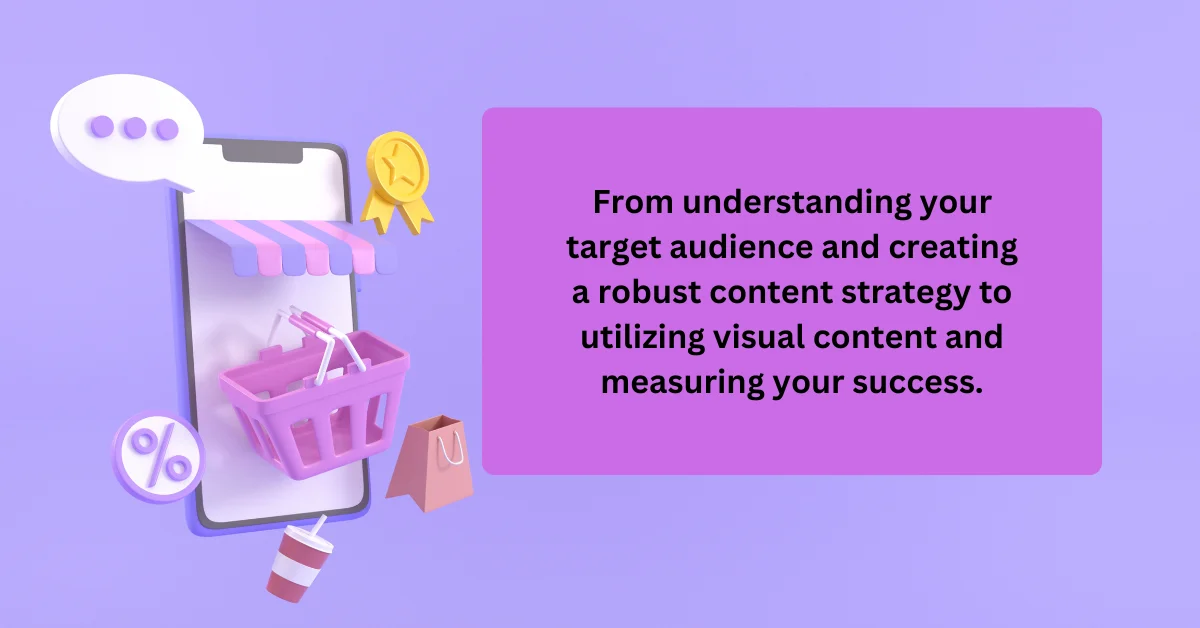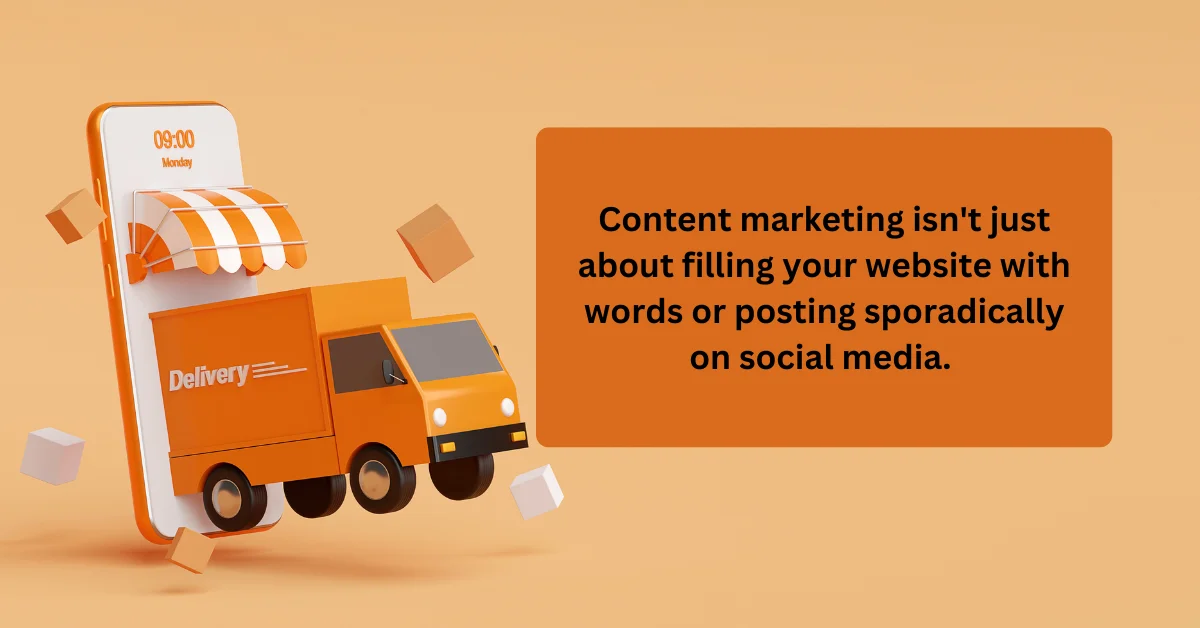In today’s digital landscape, e-commerce is rapidly growing, with online sales projected to reach $6.3 trillion by 2024. Amidst this boom, standing out in a crowded marketplace has become more challenging than ever. With countless competitors vying for consumer attention, how do you make sure your products shine and your brand resonates? The answer lies in crafting compelling content that not only informs but also captivates and converts.
Content marketing is more than just a buzzword—it’s a crucial strategy for any online store aiming to boost sales and build a loyal customer base. Effective content marketing can help you connect with your audience on a deeper level, showcase the unique value of your products, and guide potential customers smoothly down the path to purchase.
In this ultimate guide, we’ll delve into the essential strategies of e-commerce content marketing. From understanding your target audience and creating a robust content strategy to utilizing visual content and measuring your success, we’ll cover everything you need to know to create content that not only captures attention but also drives sales. Let’s get started!
1. Understanding E-commerce Content Marketing
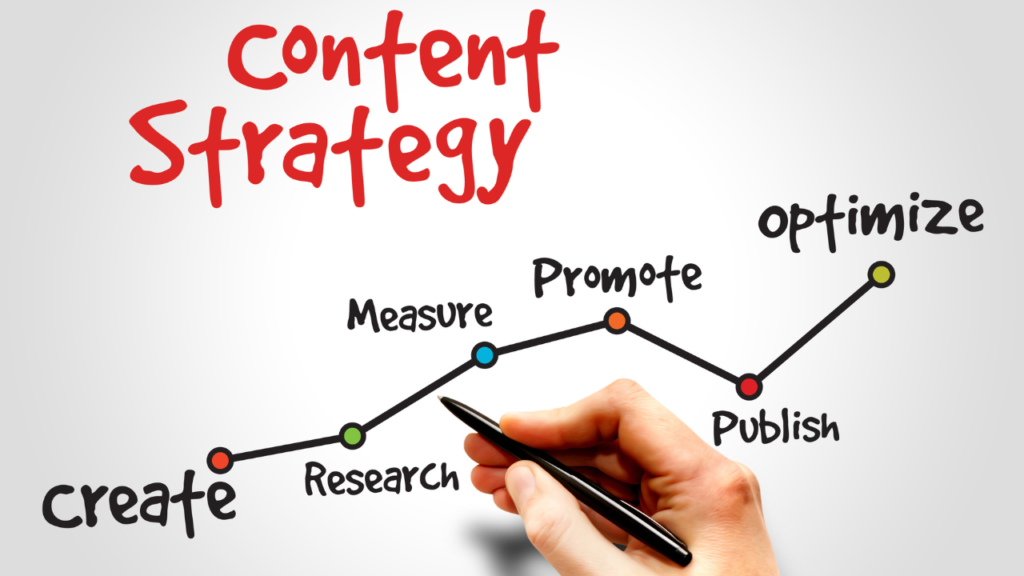
Definition: What is E-commerce Content Marketing?
E-commerce content marketing is the practice of creating and sharing valuable, relevant, and consistent content to attract and engage an audience, ultimately driving profitable customer action. Unlike traditional advertising, which directly promotes products, content marketing focuses on delivering information that is useful, entertaining, or inspiring to the audience. This approach builds trust, educates potential buyers, and positions your brand as a thought leader in your niche.
For e-commerce businesses, content marketing is a powerful tool to differentiate your brand in a crowded market. It allows you to showcase the unique benefits of your products, provide solutions to customer pain points, and foster a loyal community around your brand.
Importance: Why is Content Marketing Crucial for E-commerce?
The importance of content marketing in e-commerce cannot be overstated. Here are some key reasons why it is essential:
- Builds Brand Awareness: High-quality content helps establish your brand’s presence online. By consistently providing valuable information, you become a go-to resource for your target audience, increasing visibility and awareness.
- Drives Organic Traffic: Content optimized for search engines (SEO) can significantly boost your website’s traffic. When your content ranks higher in search engine results, potential customers are more likely to discover your online store.
- Increases Conversions: Compelling content guides potential customers through the sales funnel, from initial awareness to consideration and finally to decision-making. By addressing customer needs and showcasing how your products provide solutions, content marketing can improve conversion rates.
- Builds Trust and Authority: Content that educates and informs can position your brand as an authority in your industry. By providing valuable insights and expert advice, you build trust with your audience, which is crucial for driving long-term customer loyalty.
- Supports Social Proof: Content, such as customer reviews, testimonials, and case studies, acts as social proof that your products deliver value. This can persuade hesitant buyers to make a purchase, knowing that others have had positive experiences.
By understanding the fundamental role of content marketing in e-commerce, you can begin to harness its full potential to boost your sales and grow your brand.
2. Identifying Your Target Audience

Market Research: The Foundation of Understanding Your Audience
Before you can create compelling content that drives sales, you need to have a deep understanding of who your audience is. Market research is the cornerstone of this understanding. It involves gathering data about your potential customers, including their demographics, purchasing behaviors, preferences, and pain points. This information helps you tailor your content to meet their specific needs and interests.
Start by analyzing your existing customer data. Look at purchase histories, website analytics, and social media insights to identify trends and patterns. What are the common characteristics of your most loyal customers? What products are they most interested in? How do they interact with your content? The answers to these questions will help you build a comprehensive picture of your target audience.
Buyer Personas: Creating Detailed Customer Profiles
Once you have a solid grasp of your audience through market research, the next step is to create detailed buyer personas. A buyer persona is a semi-fictional representation of your ideal customer, based on data and research. It includes information such as age, gender, occupation, interests, challenges, and buying habits.
Here’s how to create a buyer persona for your e-commerce business:
- Demographics: Start with basic information like age, gender, income level, education, and location.
- Psychographics: Dive deeper into your customers’ personalities. What are their hobbies and interests? What values do they hold? What lifestyle do they lead?
- Pain Points: Identify the problems or challenges your customers face that your products can solve. This is crucial for creating content that resonates with your audience.
- Buying Behavior: Understand how your customers make purchasing decisions. Do they research extensively before buying? Are they influenced by social proof like reviews and testimonials?
By creating detailed buyer personas, you can craft content that speaks directly to your audience’s needs, desires, and challenges. This personalized approach increases the chances of converting visitors into customers.
Pain Points and Solutions: Addressing Your Audience’s Needs
Understanding your audience’s pain points is key to creating content that not only attracts attention but also converts. Pain points are the specific problems or challenges that your audience faces, and your content should position your products as the solution to these issues.
For example, if you run an online store that sells eco-friendly products, your audience might be concerned about sustainability and reducing their carbon footprint. Content that addresses these concerns, such as blog posts about sustainable living or videos showcasing your eco-friendly practices, will resonate with them and build trust in your brand.
When you address your audience’s pain points effectively, you demonstrate that you understand their needs and are committed to helping them find solutions. This not only strengthens your relationship with your audience but also increases the likelihood of them choosing your products over competitors.
3. Creating a Content Strategy for E-commerce
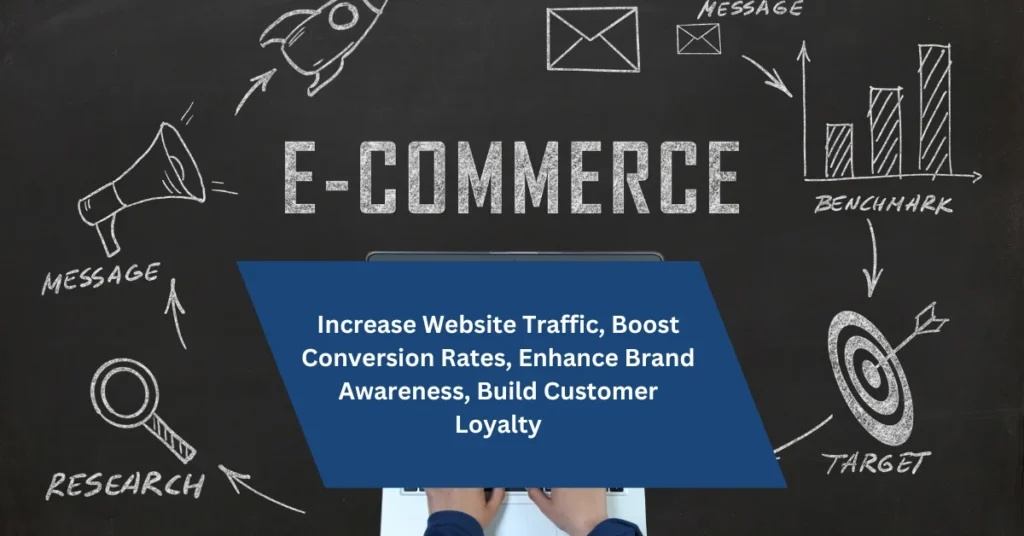
Goal Setting: Defining Your Objectives
Before diving into content creation, it’s crucial to define clear and measurable goals for your e-commerce content marketing strategy. These goals will guide your efforts and help you evaluate the success of your content. Here are some common objectives to consider:
- Increase Website Traffic: Attract more visitors to your online store through engaging content that ranks well on search engines.
- Boost Conversion Rates: Turn visitors into customers by creating persuasive content that highlights the benefits of your products.
- Enhance Brand Awareness: Establish your brand as a trusted authority in your niche by consistently publishing valuable and relevant content.
- Build Customer Loyalty: Foster long-term relationships with your audience by providing content that educates, entertains, and engages.
When setting goals, use the SMART criteria (Specific, Measurable, Achievable, Relevant, and Time-bound) to ensure that your objectives are clear and attainable. For example, instead of setting a vague goal like “increase traffic,” aim for “increase website traffic by 25% over the next three months through SEO-optimized blog posts and social media campaigns.”
Content Types: Choosing the Right Formats for Your Audience
To create an effective content strategy, it’s important to choose the right types of content that resonate with your audience and align with your goals. Here are some content formats that work well for e-commerce:
- Blog Posts: Informative and SEO-friendly blog posts can drive organic traffic to your site. Focus on topics that address your audience’s interests and pain points, and include keywords relevant to your niche.
- Product Descriptions: Compelling product descriptions that highlight the unique features and benefits of your products can enhance the shopping experience and encourage conversions.
- Videos: Videos are a powerful tool for showcasing products, demonstrating how they work, and sharing customer testimonials. They can also help build trust and credibility with your audience.
- User-Generated Content: Encourage customers to share their experiences with your products on social media. User-generated content, such as reviews, photos, and videos, serves as authentic social proof that can influence potential buyers.
- Infographics: Visual content like infographics can simplify complex information and make it more digestible and shareable. Use infographics to highlight key benefits of your products, share industry insights, or showcase customer testimonials.
By diversifying your content types, you can engage your audience through multiple channels and keep your marketing efforts fresh and interesting.
Content Calendar: Planning for Consistency and Success
Consistency is key to a successful e-commerce content marketing strategy. A well-organized content calendar helps you plan and schedule your content in advance, ensuring that you publish regularly and maintain a steady stream of fresh, relevant material for your audience.
To create an effective content calendar:
- Identify Key Dates and Events: Plan content around important dates such as product launches, holidays, sales events, and industry-specific dates that are relevant to your audience.
- Set a Publishing Frequency: Decide how often you will publish new content. This will depend on your resources and audience preferences, but consistency is more important than frequency. It’s better to publish high-quality content less frequently than to churn out low-quality content daily.
- Outline Content Themes: Identify core themes or topics that align with your brand and audience interests. This will help you maintain a cohesive content strategy and ensure that your messaging is consistent across all platforms.
- Assign Responsibilities: If you have a team, clearly define who is responsible for each piece of content, from creation to publishing. This will help streamline the content production process and ensure accountability.
By following these steps, you can create a content calendar that keeps your marketing efforts on track and helps you achieve your business goals.
4. Crafting Compelling Product Descriptions

Features vs. Benefits: Highlighting What Matters Most
One of the most common mistakes in e-commerce content is focusing too much on product features and not enough on benefits. While features are important, they describe what a product is or does; benefits, on the other hand, explain how a product improves the customer’s life or solves a problem. When crafting product descriptions, it’s crucial to strike the right balance between features and benefits to make your products irresistible.
Example of Features vs. Benefits:
- Feature: “This blender has a 1000-watt motor.”
- Benefit: “Blend smoothies and soups to a silky consistency in seconds with a powerful 1000-watt motor.”
By shifting the focus from the technical specifications (features) to the customer experience (benefits), you create a more compelling narrative that resonates with potential buyers.
SEO Optimization: Driving Traffic with Keyword-Rich Descriptions
Optimizing your product descriptions for search engines is essential for driving organic traffic to your e-commerce site. Here are some tips for creating SEO-friendly product descriptions:
- Keyword Research: Identify relevant keywords that your potential customers are likely to use when searching for products like yours. Tools like Google Keyword Planner, Ahrefs, or SEMrush can help you find the right keywords.
- Strategic Placement: Incorporate your target keywords naturally throughout the product description, including in the title, headings, bullet points, and meta descriptions. Avoid keyword stuffing, which can harm your SEO and make the text less readable.
- Unique Descriptions: Ensure each product description is unique, even if similar products have similar features. Search engines penalize duplicate content, so take the time to write original descriptions for each product.
- Readable and Scannable: Use bullet points, short paragraphs, and subheadings to make your descriptions easy to read. This not only improves the user experience but also helps search engines understand the content better.
By combining relevant keywords with compelling descriptions, you can improve your product pages’ visibility in search engines and attract more potential customers.
Storytelling: Engaging Customers with a Narrative
Storytelling is a powerful tool in e-commerce content marketing that can transform your product descriptions from mundane to memorable. By weaving a narrative around your products, you can create an emotional connection with your audience and make your products more appealing.
Here’s how to use storytelling in your product descriptions:
- Create a Scenario: Paint a picture of how the customer will use the product and how it will enhance their life. For example, “Imagine starting your day with a freshly brewed cup of coffee made with our artisanal beans, roasted to perfection to bring out the rich, full-bodied flavor.”
- Use Descriptive Language: Choose words that evoke sensory experiences and emotions. Instead of saying “comfortable shoes,” describe them as “cushioned with soft, breathable fabric for all-day comfort.”
- Incorporate Brand Voice: Ensure that your storytelling aligns with your brand’s voice and values. Whether your brand is playful, sophisticated, or eco-friendly, your product descriptions should reflect that personality.
By incorporating storytelling into your product descriptions, you can engage your customers on a deeper level and make your products stand out in a crowded market.
5. Utilizing Visual Content to Boost Engagement

Importance of Visuals: Capturing Attention and Driving Sales
In the digital world, visuals are a powerful tool for e-commerce businesses. High-quality images, videos, and infographics not only capture attention but also help convey the value of your products quickly and effectively. Humans are inherently visual creatures—90% of the information processed by the brain is visual, and content with compelling visuals can increase engagement and conversions significantly.
Visual content enhances the shopping experience by allowing customers to see and understand your products better. It builds trust by providing a realistic view of what they are purchasing, reducing the chances of returns due to unmet expectations. Here’s how you can leverage different types of visual content to boost engagement and drive sales:
Video Marketing: Showcasing Products and Building Trust
Video is one of the most engaging forms of content, and it plays a crucial role in e-commerce marketing. Videos can showcase your products in action, demonstrate their features and benefits, and provide valuable information that helps customers make informed decisions.
Types of Video Content for E-commerce:
- Product Demos: These videos show your products in use, highlighting key features and benefits. For example, a video demonstrating the ease of use of a kitchen appliance can help customers visualize how it would fit into their daily routines.
- Tutorials and How-To Videos: These provide step-by-step instructions on how to use your products, helping customers feel more confident about their purchase. For example, a skincare brand might create tutorials on how to apply its products for maximum benefit.
- Customer Testimonials: Videos featuring satisfied customers sharing their positive experiences can build trust and provide social proof. Seeing real people endorse your products can be more convincing than written reviews.
- Behind-the-Scenes Content: Videos that show the making of your products or your company culture can humanize your brand and create a stronger emotional connection with your audience.
By incorporating a variety of videos into your content strategy, you can appeal to different stages of the buyer’s journey and provide a richer, more engaging shopping experience.
User-Generated Content: Leveraging the Power of Your Customers
User-generated content (UGC) is any form of content—such as photos, videos, reviews, and social media posts—created by your customers. UGC is a highly effective form of visual content because it serves as authentic social proof that can influence potential buyers. When customers see real people enjoying your products, they are more likely to trust your brand and make a purchase.
Strategies for Encouraging User-Generated Content:
- Create Branded Hashtags: Encourage your customers to share their experiences using a specific hashtag. This makes it easy for you to find and share their content on your own channels.
- Host Contests and Giveaways: Run social media contests that encourage customers to share photos or videos of themselves using your products. Offer a prize to the best submission to motivate participation.
- Feature Customer Photos and Videos: Showcase UGC on your product pages, social media, and marketing emails. Highlighting your customers’ content not only builds community but also serves as a powerful endorsement of your products.
- Ask for Reviews: Encourage customers to leave reviews and upload photos or videos of their purchases. This not only provides valuable feedback but also enhances your product pages with authentic, relatable content.
By leveraging user-generated content, you can build trust, increase engagement, and create a sense of community around your brand, all of which contribute to driving sales.
Infographics: Making Information Easy to Digest
Infographics are a versatile form of visual content that can simplify complex information and make it more engaging. They are particularly useful for sharing data, statistics, or step-by-step processes in a visually appealing format. In e-commerce, infographics can be used to:
- Highlight Product Benefits: Create infographics that showcase the key benefits of your products in a clear, concise manner.
- Share Industry Insights: Use infographics to present valuable information about your industry or market trends, positioning your brand as an expert.
- Illustrate Customer Journeys: Show potential customers the typical path from discovery to purchase, highlighting how your products solve common pain points.
By integrating infographics into your content strategy, you can provide valuable information in an easily digestible format that is more likely to be shared and remembered.
6. Leveraging Social Media for E-commerce Content Marketing
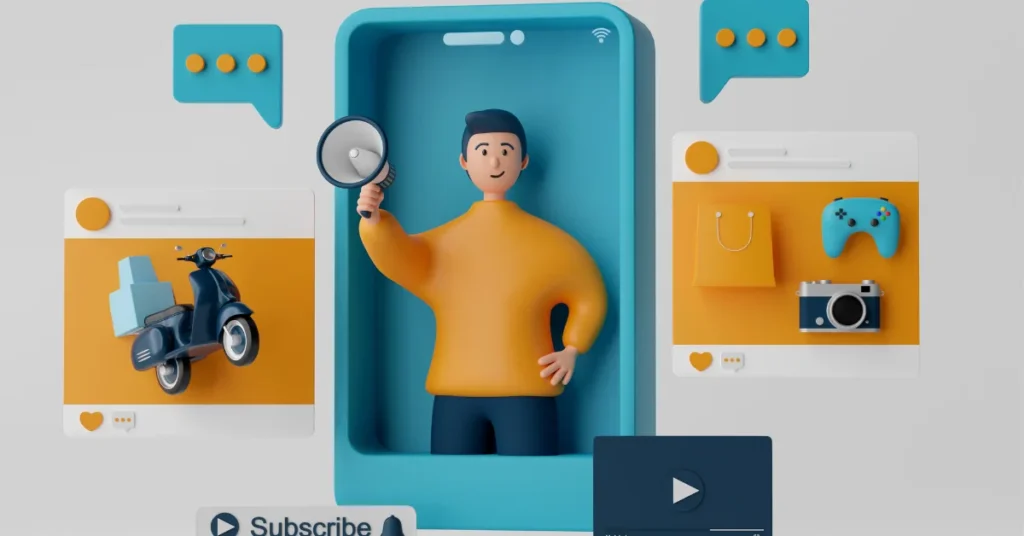
Platform Selection: Choosing the Right Social Media Channels
Social media is a powerful tool for e-commerce content marketing, offering a dynamic platform to engage with your audience, promote your products, and drive traffic to your online store. However, with so many social media channels available, it’s crucial to choose the ones that align best with your brand and target audience.
Here’s how to choose the right social media platforms for your e-commerce business:
- Understand Your Audience: Different social media platforms attract different demographics. For example, Instagram and TikTok are popular among younger audiences, while Facebook has a broader user base that includes older demographics. LinkedIn is ideal for B2B marketing and professional services.
- Consider Your Content Type: The type of content you produce should influence your platform choice. If your content strategy includes a lot of visuals, Instagram and Pinterest might be the best options. For video content, YouTube and TikTok are excellent choices. Twitter is great for sharing news and engaging in conversations, while Facebook is versatile for various content types.
- Analyze Your Competitors: Look at where your competitors are active and successful. This can give you insights into which platforms might work well for your brand. However, don’t just copy what they’re doing; use this information as a guide and build your unique strategy.
By carefully selecting the social media platforms that best match your audience and content, you can maximize your reach and engagement, driving more traffic to your online store.
Content Promotion: Strategies for Effective Social Media Marketing
Once you’ve chosen the right platforms, the next step is to promote your content effectively. Here are some strategies to enhance your social media marketing efforts:
- Create Shareable Content: Produce high-quality, engaging content that your audience will want to share. This could be anything from visually appealing product images and videos to informative blog posts and infographics.
- Use Hashtags Strategically: Hashtags can increase your content’s visibility on social media. Research popular hashtags in your niche and use them to reach a broader audience. Create a branded hashtag to encourage user-generated content and increase brand recognition.
- Engage with Your Audience: Social media is all about building relationships. Respond to comments, answer questions, and engage with your followers. This not only humanizes your brand but also fosters a loyal community around your products.
- Run Social Media Ads: Organic reach on social media can be limited, so consider investing in paid advertising to promote your content and products. Platforms like Facebook, Instagram, and Pinterest offer targeted ad options that can help you reach specific audience segments based on demographics, interests, and behavior.
- Leverage Influencer Marketing: Partnering with influencers can help you reach new audiences and build credibility. Choose influencers who align with your brand values and have a following that matches your target audience.
By implementing these strategies, you can effectively promote your e-commerce content on social media and drive more traffic and sales to your online store.
Engagement and Community Building: Fostering a Loyal Customer Base
Building a community around your brand is one of the most powerful outcomes of social media marketing. When customers feel connected to your brand, they are more likely to become repeat buyers and advocates. Here’s how to build a strong, engaged community:
- Encourage User Interaction: Ask questions, run polls, and invite your audience to share their thoughts and experiences. User interaction not only boosts engagement but also provides valuable insights into customer preferences and opinions.
- Host Live Sessions and Events: Live videos and events are great for real-time interaction with your audience. You can host product launches, Q&A sessions, behind-the-scenes tours, or live demonstrations. These events create a sense of urgency and excitement, encouraging followers to tune in and participate.
- Recognize and Reward Your Followers: Show appreciation for your followers by highlighting user-generated content, offering exclusive discounts, or hosting giveaways. Recognizing and rewarding your customers makes them feel valued and strengthens their connection to your brand.
- Consistent Branding and Messaging: Ensure your brand voice and messaging are consistent across all social media platforms. This helps build a cohesive brand identity that customers can easily recognize and connect with.
By focusing on engagement and community building, you can create a loyal customer base that not only supports your brand but also helps spread the word, driving organic growth and sales.
7. Measuring and Analyzing Content Performance

Key Metrics: Understanding What to Track
To ensure your e-commerce content marketing strategy is effective, it’s crucial to measure and analyze its performance. Tracking the right metrics will help you understand what’s working, what isn’t, and where you can make improvements. Here are some key metrics to focus on:
- Website Traffic: Monitor the number of visitors coming to your website from your content efforts. Look at overall traffic and traffic sources to see which channels are driving the most visitors. This helps you understand the reach of your content and how well it’s attracting potential customers.
- Conversion Rates: This metric indicates the percentage of visitors who complete a desired action, such as making a purchase, signing up for a newsletter, or downloading a guide. High conversion rates indicate that your content is persuasive and aligns well with your audience’s needs.
- Bounce Rates: A high bounce rate means visitors are leaving your site after viewing just one page, which could suggest that your content isn’t engaging or relevant to their needs. Aim for a low bounce rate, indicating that visitors are exploring more of your website.
- Social Engagement: Track likes, shares, comments, and other interactions on your social media posts. High engagement rates suggest that your content resonates with your audience and encourages interaction.
- Click-Through Rates (CTR): Measure the percentage of people who click on a link within your content, whether it’s an email, social post, or ad. A high CTR means your content is compelling and your call-to-action (CTA) is effective.
- Customer Retention and Loyalty: Look at metrics like repeat purchase rates and customer lifetime value (CLV) to assess how well your content is helping to retain customers and encourage repeat business.
By regularly monitoring these metrics, you can gain valuable insights into your content’s effectiveness and identify areas for improvement.
Tools for Analysis: Making Data-Driven Decisions
To accurately measure and analyze your content performance, you’ll need the right tools. Here are some popular analytics tools that can help:
- Google Analytics: A powerful tool for tracking website traffic, user behavior, and conversion rates. It provides detailed insights into how visitors interact with your site, where they come from, and what content drives the most engagement.
- Social Media Insights: Most social media platforms offer built-in analytics tools that provide data on post engagement, follower growth, and audience demographics. Use these insights to refine your social media strategy and content.
- Email Marketing Tools: Platforms like Mailchimp, HubSpot, and Constant Contact offer analytics for tracking open rates, click-through rates, and conversions from your email campaigns. This helps you understand how well your emails are performing and where you can improve.
- SEO Tools: Tools like Ahrefs, SEMrush, and Moz can help you track keyword rankings, backlinks, and organic traffic. These insights are invaluable for optimizing your content for search engines and improving your SEO strategy.
- Heatmaps and User Session Recording: Tools like Hotjar or Crazy Egg provide visual insights into how users interact with your website. Heatmaps show where users click, scroll, and hover, helping you understand what captures their attention and where you might be losing them.
By leveraging these tools, you can make data-driven decisions to optimize your content strategy and improve overall performance.
Continuous Improvement: Using Data to Refine Your Strategy
Analyzing your content performance isn’t a one-time task—it’s an ongoing process that helps you continuously refine your strategy for better results. Here’s how to use data for continuous improvement:
- Identify Trends: Regularly review your analytics to spot trends and patterns. For example, if you notice that certain types of content consistently perform better, consider creating more of that content.
- Test and Learn: Experiment with different content types, formats, and promotional strategies to see what resonates best with your audience. Use A/B testing to compare different versions of content and see which one performs better.
- Optimize Based on Feedback: Pay attention to customer feedback and reviews. If customers frequently mention a particular pain point or request specific information, create content that addresses those needs.
- Adjust Your Goals: As you learn more about your audience and what works, refine your goals and objectives. Set new targets based on past performance to push your content strategy to new heights.
By embracing a culture of continuous improvement, you can ensure that your e-commerce content marketing strategy remains effective, engaging, and aligned with your business goals.
Conclusion
In the fast-paced world of e-commerce, content marketing is a vital tool that can help your brand stand out and drive significant sales. By understanding the nuances of e-commerce content marketing—from identifying your target audience to creating a robust content strategy—you can effectively engage potential customers and guide them through the purchasing journey.
Crafting compelling product descriptions that highlight benefits, optimizing your content for SEO, and leveraging storytelling can make your products irresistible to your audience. Additionally, utilizing visual content such as videos and user-generated content can enhance engagement and build trust, while strategic use of social media platforms can expand your reach and foster a loyal community.
Measuring and analyzing your content’s performance with the right metrics and tools allows you to make data-driven decisions that continuously improve your strategy. By setting clear goals and adapting based on insights, you can ensure your content remains relevant, impactful, and aligned with your business objectives.
Content marketing is not a one-size-fits-all approach but a dynamic, evolving process. With dedication and creativity, you can develop a content strategy that not only boosts traffic and conversions but also builds lasting relationships with your customers. Start implementing these strategies today, and watch as your e-commerce business grows and thrives.

